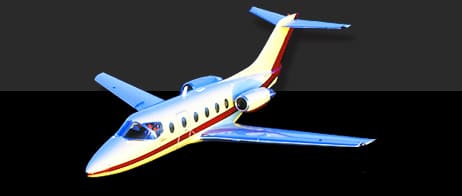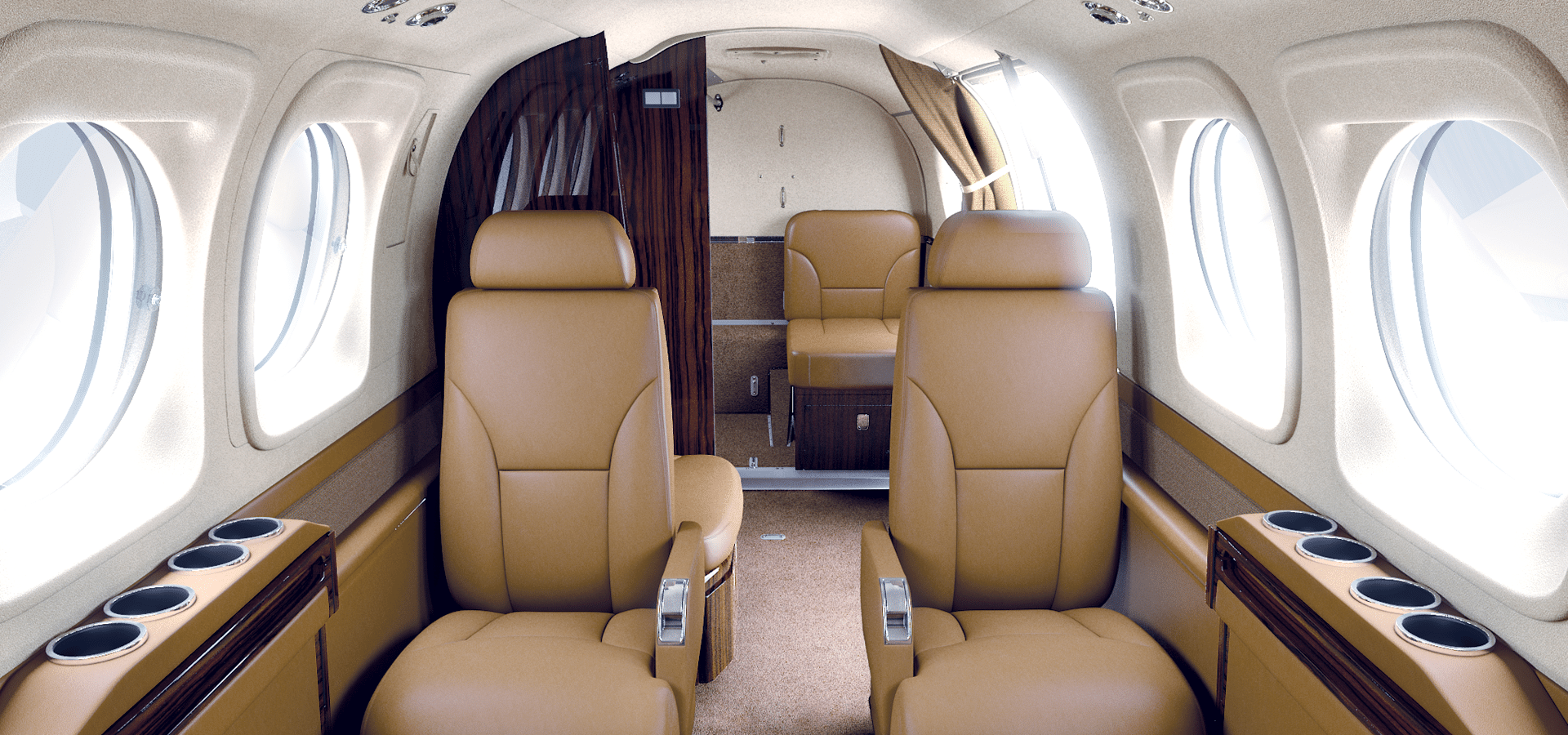Operators of the roughly 600 Beechjet 400A Hawker 400XP in service say that the aircraft is one of the most versatile, comfortable, and economic light jets ever built, a tribute to the detailed design work done by Mitsubishi Heavy Industries (MHI) in the early 1970s to create its predecessor, the Diamond I. They also say the 400A/400XP have shortcomings, especially their heavy roll control effort and sluggish runway performance. Maintenance technicians say component access is tough and some aging systems need upgrading.
“Great cabin and cockpit size. It’s built like a tank but it flies like a dump truck,” says a pilot for a large Midwest management and charter firm. Operators also say it’s fast for a light jet and has a good ride in turbulence due to its relatively high wing loading.
Many of these comments can be traced back to the origins of MHI’s Diamond I development program in the late 1960s when the firm started extensive market research. Potential customers said they wanted a better combination of cabin comfort, cruise speed, and fuel efficiency than that offered by Citation 500 and Learjet 20/30 series aircraft that were designed a decade earlier.
So, MHI engineers endowed their new jet with a 400-cu.-ft. pressure vessel and a relatively small, high lift-to-drag wing. Using the latest computational fluid dynamics (CFD) and computerized structural design tools at the time, they created a 241-sq.-ft., supercritical wing — one of the first in the segment — that would enable the aircraft to cruise efficiently at Mach 0.73 to 0.76 while also taking weight out of the airframe.
The resulting late 1970s Diamond I prototype had a wider and taller cabin than other light jets then in production and it also could cruise at 425 KTAS in mid weights. Unlike most other light jets of the era, it had a flat floor and ample foot room.
MHI then ran into stiff certification headwinds. It attempted to comply with every FAA suggestion as well as every mandate. The development program dragged on for an extra 18 months, mainly due to the imposition of much stricter FAR Part 25 certification rules in the wake of the McDonnell Douglas DC-10 crash at Chicago O’Hare Airport in May 1979.
By the time MHI complied with all the new requirements and achieved certification in November 1981, the Diamond I’s weight had ballooned 900 lb., its runway, climb and cruise performance suffered and its tanks-full payload went down. Its 1970s-vintage 2,500-lb.-thrust Pratt & Whitney Canada JT15D-4 engines were too weak for its weight. More potent power plants were needed to cure its problems.
The solution came in 1984 when P&WC earned certification for the 2,900-lb.-thrust JT15D-5, offering more thrust and better high-altitude performance for the Diamond. While the -5 also had the lowest bypass ratio of any of the JT15D variants and produced the most noise, it did make possible the 1985 Diamond II, a considerably more capable aircraft than its predecessor.
Yet, plenty of post-certification development work still lay ahead.
Battle fatigued, MHI built fewer than a dozen Diamond II jets. Fortunately, Beech Aircraft Corp. long lusted for a light jet to call its own, one that would provide a step up from its King Air turboprop line. So, in early 1986, the Wichita firm bought the Diamond I and II programs from MHI, renamed the latter as the Beechjet 400, and set up its own production line at Beech Field in Wichita.
Beech immediately started honing its new gem in the rough. As inherited from MHI, the Model 400’s ceiling was limited to 41,000 ft., its range was too short and its weights were too low. Eying its potential, though, Beech developed a follow-on model that remedied many of the 400’s shortcomings.
The result was the 1990 Beechjet 400A, an aircraft with better interior space utilization, more cabin utility, and more capable avionics, plus a 4,000-ft. higher cruising altitude, more range, and higher operating weights. Serial numbers RK-0001 through RK-0353 were built between 1990 and 2003.
At that point, the aircraft was rebadged as the Hawker 400XP and upgraded with standard vapor cycle air-conditioning, plus her interior fittings, TCAS II, E GPWS, and dual FMS. The 400XP, with s.n. RK-0354 through RK-0604 were built from 2003 to 2010.
The firm also successfully developed the Model 400T, a military variant known as the T-1A Jayhawk that featured increased fuselage fuel capacity, single-point pressure refueling, and structural reinforcements allowing Vmo to be increased. Ultimately, 180 T-1A aircraft were delivered to the U.S. Air Force, and another 13 were sold to Japan.
Operators say that cabin comfort is what gives this aircraft enduring value. Today, the aircraft’s biggest drawback is its 40-year-old technology, 2,900-lb.-thrust JT15D-5/-5R engines. These are relatively low bypass ratio, low overall pressure ratio turbofans that run out of steam as the aircraft climbs through FL 300 and are much thirstier than more modern powerplants in the 3,000- to 4,000-lb.-thrust class. Eventually, engine obsolescence is likely to doom them to the scrapyards.
People who fly the Beechjet 400A Hawker 400XP also are concerned about their aging Pro Line 4 avionics packages. While Rockwell Collins continues to support these systems, it’s going to be more difficult to find replacement CRT displays in today’s flat-panel era.
Nextant Aerospace and Textron’s Hawker Beechcraft Service unit believe Beechjet 400A Hawker 400XP aircraft have second lives when they are upgraded with new technology Williams International FJ44-series powerplants, among other modifications including flat-panel avionics and new interiors. However, a full makeover can cost $4 million or more, not including the base airplane.
We asked operators if they favored keeping their Beechjet 400A Hawker 400XP in original condition or whether they thought upgrading was a cost-effective alternative to prolong their useful service lives. We also took an in-depth look at the airplane and its systems to put those views into perspective.
Operator Profiles and Opinions
Most Beechjet 400A Hawker 400XP aircraft are U.S. registered with single aircraft operators accounting for a majority of the fleet. Flight Options and Travel Management Co. are the largest fleet operators. Netjets Europe has disposed of its Hawker 400XP fleet.
The second highest concentration is in Mexico. The third largest number is in Brazil, but a large portion of those aircraft are for sale as operators step up to newer aircraft, such as the Embraer Phenom 300. With six 400XP aircraft, Saudia Private Aviation is the largest operator in the Middle East, but all of its five-year-old, low-time airplanes are for sale.
The rest of the aircraft are scattered throughout Asia, Australia, and the Americas, along with Europe, the Middle East, and Africa.
The USAF operates 178 Beechjet 400T T-1A Jayhawks that also could be re-engined with FJ44 turbofans, thereby greatly extending their service lives. Upgrading these aircraft would be far less expensive than replacing them with new light jets.
Most corporate operators fly their aircraft no more than 300 to 400 hr. per year. Charter aircraft and fractional operators average closer to 800 to 900 hr. per year, or more. Typical missions for Beechjet 400A Hawker 400XP aircraft are 1.5 to 2.0 hr. with block speeds just under 400 kt. Most pilots of JT15D-5/-5R-powered aircraft say they’re comfortable flying the jet 3+00 hr., or about 1,175 nm while cruising at Mach 0.73 to 0.76. For our 2010 Purchase Planning Handbook, Beechcraft said the aircraft could fly four passengers 1,351 nm, cruising at Mach 0.71 to 0.73, and land with 100-nm NBAA IFR reserves.
First-hour fuel burn for JT15D-5-powered aircraft averages 1,500 lb., according to operators. Second-hour fuel flow drops to 1,100 to 1,200 lb. per hour, depending upon aircraft weight, altitude, and cruise speed.
Nextant 400XT operators report far more miserly fuel flows. They report average mission lengths closer to 3 hr. They’re comfortable flying the jet 4+45 to 5+00 hr. First-hour fuel burns average 1,200 lb., particularly because of the aircraft’s ability to climb swiftly above FL 300 and cruise at Mach 0.75 to 0.78 at FL 430 to FL 450. Second-hour fuel burn drops to 850 to 900 lb./hr. at high-speed cruise. But slow it down to Mach 0.73 to stretch the range and fuel flow drops to 750 to 875 lb./hr., depending upon weight and cruise altitude.
Most Beechjet 400A Hawker 400XP operators report basic operating weights that range from 11,000 to 11,100 lb. That compares favorably with the 10,985-lb. BOW Hawker Beechcraft reported for our May 2010 Purchase Planning Handbook. Nextant 400XT operators are reporting similar 11,000- to 11,100-lb. BOWs, even though Nextant says that typical BOWs are 10,600 lb. for the 400XT and 10,800 lb. for the plusher, current-production 400XTi. Hawker Beechcraft Services estimates that BOW for its upcoming 400XPr will be 10,900 lb., but no production aircraft has yet rolled out of the shop to verify that claim.
Original equipment Rockwell Collins Pro Line 4 flight decks, featuring obsolete CRT displays and having few of the functions needed to operate in the 21st-century airspace system, also are in need of upgrading. Credit: Textron Aviation
Thus, the typical tank-full payload for all three models in current operation is less than 500 to 600 lb. But in everyday operations the average passenger load is three people, operators say. Each additional passenger aboard the Beechjet 400A Hawker 400XP reduces the range by about 80 mi. and about 110 mi. aboard the 400XT. Put another way, Beechjet 400A Hawker 400XP models can fly six passengers at about 1,100 nm while the 400XT can fly them at more than 1,500 nm. The 400XPr should meet or exceed the 400XT’s range performance, according to Brian Howell, Hawker Beechcraft Services’ vice president of global customer support.
Operators of Beechjet 400A Hawker 400XP aircraft generally are satisfied with, but not enthusiastic about, the jets’ capabilities. They do like their smooth ride in turbulence, ramp appeal, and relatively high cruise speed compared to other light jets, along with their cockpit and cabin comfort and simple systems.
People who fly the 400XT have a brighter outlook. They boast of their climb capabilities, fuel efficiency, quiet interior, and Rockwell Collins Pro Line 21 avionics suite.
Hot, high, and heavy airport performance is somewhat improved compared to the original aircraft. When departing a 5,000-ft. elevation airport at MTOW at flaps 10 deg., the maximum allowable OAT for Beechjet 400A Hawker 400XP aircraft is 21C. For 400XT aircraft, the max OAT for those conditions is 25C. It’s apparent that OEI climb performance and brake energy limits still are concerns when departing airports higher than 5,000 ft. elevation at temperatures above ISA+20C.
Hawker Beechcraft Services, in contrast, projects a max allowable OAT of 39C for its 400XPr when at MTOW departing a 5,000-ft. elevation airport using flaps 10 deg.
Operators of all three models aren’t shy about discussing the aircraft’s shortcomings. They say its lack of ailerons and reliance on roll spoilers makes roll control effort too heavy. It also makes it difficult to use a wing down/top rudder sideslip technique for crosswind landings.
Stopping performance also is problematic for many pilots. When braking the aircraft, it’s tough to be smooth with the anti-skid system in operation. The single-wheel main tires tend to hydroplane on wet runways and the JT15D-5 engines have relatively high thrust at ground idle. Thrust reversers provide much improved stopping performance on contaminated pavement.
Braking action seems to be less of a problem for 400XT operators, even though the FJ44-3AP turbofans lack thrust reversers. The engines’ FADECs reduce N2 ground idle speed with weight on wheels, so there is substantially less residual thrust. But the wheel brakes still are difficult to modulate smoothly without extensive practice.
Nosewheel steering earned no plaudits either. Mechanical links through the rudder pedals provide +/-25 deg. of steering authority, but the pedal feel is stiff. The nosewheel will free the caster to 45 deg. using differential thrust and brakes.
Refueling the aircraft is cumbersome as there are three filling ports, one in each wing and one in the top right side of the fuselage to replenish the aft and belly tanks. Decades ago, Beech studied the feasibility of installing a single-point pressure refueling port, similar to the system aboard the 400T Jayhawk, but the firm never completed the project for the Beechjet 400A Hawker 400XP models.
The aft external baggage compartment has a 26.4-cu.-ft. volume, smallish by current standards. Today’s light jets have 45- to 71-cu.-ft. baggage compartments. Also, operators don’t like the internally serviced aft lavatory. Many said the aircraft needs an externally serviced water and waste system.
Aircraft and Systems
Operators say that the basic airframes, including metalwork, fairings, doors, and transparencies are holding up well. MHI’s proprietary MAC510 supercritical wing enables the aircraft to cruise efficiently at Mach 0.73. The aircraft can go as fast as Mach 0.78, its Mmo redline. For JT15D-5-powered aircraft, the range drops 6%. The FJ44-powered models lose 10+% range at maximum cruise speed.
The Beechjet 400A Hawker 400XP and 400XT aircraft have 305-cu.-ft. passenger cabins, offering interior volume equaled by a few other light jets of that vintage. Cabin volume was squandered in the first-generation Beechjet 400 because of the location of the right-side emergency exit, an aftermarket fuselage fuel tank that shortened available cabin length by several inches, and a forward lav across from the entry door that occupied prime real estate in the cabin.
For the 400A, engineers in Wichita reconfigured the aircraft’s fuselage fuel tanks for better cabin space utilization, moved the right-side emergency exit forward by one window, and installed a proper, full-width lavatory at the rear of the cabin. The redesign allowed double club seating for eight passengers or a center club with one or two aft-facing chairs in the forward cabin and two forward-facing chairs in the aft cabin. Aftermarket layouts feature an aft club section with a forward three-place divan on one side and a single chair on the other.
When the 400XP went out of production in 2010, it was the last light jet to be powered by JT15D engines. All other light jet makers had migrated to newer technology engines, such as the FJ44 series turbofans that power current-generation narrowbody Citations.
The FJ44-3 and -4 variants are well suited as replacements for the original JT15D-5/-5R engines on Beechjet 400A Hawker 400XP aircraft. They offer superior heavy/hot/high performance, one-third better fuel efficiency, lower noise, and exhaust gas emissions, and longer times between overhauls.
In October 2011, Nextant Aerospace became the first firm to earn an STC for retrofitting 3,050 lb.-thrust FJ44‑3AP engines to the aircraft. Its Nextant 400XT, and newer 400XTi, modification programs also include completion of major inspections, overhauling or replacing several life-limited components, installation of Rockwell Collins Pro Line 21 avionics, and new paint and interior refurbishing, among several other upgrades. By the end of 2014, Nextant will have completed 50 modifications. It has another 50 orders from Travel Management Co., so the program is a strong success, considering the initial $20 million investment in the project.
However, 400XT operators say that success is taxing Nextant’s support and training resources. Technical support is good through factory representatives and authorized service facilities, but some people feel they’re given lower priority than Flight Options, the largest current 400XT operator and a sister company of Nextant. Operators also say that the single 400XT simulator at CAE runs at max capacity because of the demands of Flight Options.
Beechjet 400A and Hawker 400XP have 305-cu.-ft. passenger cabins with flat floors and squared oval cross-sections that provide more usable head and shoulder room than in light jets with circular cross-section fuselages and dropped aisles.
Hawker Beechcraft Services expects to have an STC for retrofitting the aircraft with 3,200 lb.-thrust FJ44-4A-32 engines by early to mid-2015, thereby transforming the aircraft into a Hawker 400XPr. The new engine retrofit approval will complement its existing winglet and Pro Line 21 upgrade STCs. And, soon, HBS also anticipates offering a complete Garmin G5000 avionics and autopilot retrofit.
All 400-series aircraft have 28 VDC, parallel bus electrical systems, rather than the split bus systems in newer transport category aircraft. Electrical systems generally are reliable, but operators say that the starter generators seldom make it to 1,000 scheduled overhaul intervals without needing maintenance.
Nextant 400XT operators also say that the optional, 43 amp-hour, thin-plate, lead-acid Enersys Hawker aviation batteries are not as reliable as the original 28 AH lead-acid batteries.
Fuel systems are starting to need maintenance. Fuselage bladder tanks are developing leaks. Replacing them requires removing most of the aircraft interior. Nextant 400XT operators also say that the airframe fuel filters were removed as part of the engine upgrade program, so all debris from the tanks must be trapped by the engine fuel filters.
Operators of aircraft equipped only with air cycle machines for cabin refrigeration say that cooling performance is anemic. Passengers are uncomfortably warm in the summer months until the aircraft climbs to cruise altitude. Aircraft also fitted with vapor cycle machines provide better cooling, but refrigeration capacity is not on par with newer light jets.
Maintenance technicians lament the aircraft’s poor access for servicing and repairs. They say that one- or two-day repairs on MSG 3-compliant aircraft turn into one- or two-week repairs on 400 series aircraft. It’s imperative to get caught up on the major calendar, cycle, and hourly maintenance tasks while the aircraft’s interior is out, even though components have not reached their due dates. Deferring tasks is a sure recipe for extended shop visits. And maintenance costs only will increase as the aircraft gets older.
Worth the Investment to Upgrade?
Hawker Beechcraft Services and Nextant Aerospace officials believe that up to 200 aircraft in the Beechjet 400A Hawker 400XP fleet will be upgraded with FJ44 engines. They also think that the 180 USAF T-1A Jayhawks are excellent candidates for re-engining.
Nextant Aerospace, like Flight Options, a subsidiary of Kenn Ricci’s Directional Aviation Capital, is the first firm to offer an FJ44 re-engining package for the Beechjet. One of Ricci’s main goals was to find a way to rejuvenate Flight Options’ aging Beechjet 400A and Hawker 400XP fleet and extend the economic lives of those aircraft. So, the Nextant package includes a lot more than just new engines and new Rockwell Collins Pro Line 21 flight decks; in addition, there’s a new wiring harness, completion of major maintenance inspections, and new paint and interior. Development of winglets is well underway and certification is expected in the first quarter of 2015. An optional Safe Flight Instrument Corp. autothrottle system also is in flight testing.
By the end of 2014, Nextant will have completed 50 XT/XTi aircraft, and nearly 30 of 40 on order have been returned to the Flight Options fleet. In October 2013, Travel Management Co. announced a deal to convert all 50 of its Hawker 400XP aircraft to the Nextant 400XTi variant, boosting Nextant’s total order book to more than 100 units.
Nextant 400XT operators generally give their aircraft high marks for climb performance, Pro Line 21 avionics, fuel efficiency, and reduced operating cost. Nextant’s new challenge is beefing up product support and simulator training capabilities to meet demand.
“Our goal is to meet or exceed customer expectations,” says Sean McGeough, Nextant Aerospace’s president and CEO. He says the program has grown and matured in the past three years. Retail customers are achieving 95.8% dispatch reliability, and quality control, especially regarding interior completions, has improved markedly.
Hawker Beechcraft Services, working closely with Mark Huffstutler’s Sierra Industries, expects to have an STC for its Hawker 400XPr by the first or second quarter of 2015. HBS believes it has a better re-engining solution because Beechcraft owns the type certificate, the engineering data, and the tooling, even though the aircraft is out of production. Its officials have announced six orders from Alaskan medevac operator Guardian Flight, but they decline to disclose the total orders to date.
HBS believes that having the full backing for the 400XPr from the original manufacturer, including engineering and parts support, provides it with a competitive advantage over Nextant. Some Beechjet 400A Hawker 400XP operators say that they’re more confident that Textron Aviation will provide long-term support for the aircraft than the old Beechcraft Corp. could with its meager financial resources.
But both the 400XT and 400XPr face formidable competition in the used aircraft market, according to operators. “Sure, it’s built like a tank, but it’s getting old and it’s harder to find parts,” says the aviation director for a midsize charter and management company in the Southwest U.S. “The cost of the upgrades is a major consideration. That’s way too much money for the age and value of the Beechjet 400A Hawker 400XP. Ours are worth $650,000 or less.”
Resale values of the Beechjet 400A range from about $500,000 for mid-time 1990 models to $1.3 million for 2003 models, according to Penton’s Aircraft Bluebook Price Digest. A 2004 Hawker 400XP commands about $1.5 million and asking prices for the last 2010 models are $2.5 million or more.
The first reconditioned and re-engined 2011 Nextant 400XT aircraft sold for about $4.2 million and late model 2013 400XTi aircraft sold for just under $5 million. They now command between $3.2 million and $4.2 million in the resale market, so they’re currently holding 80 to 84% resale value.
Other Beechjet 400A Hawker 400XP operators plan to keep their aircraft for several more years and they’re likely to upgrade with new engines, avionics and passenger amenities. But they’re in no hurry, as their aircraft have mid-time engines. JT15D-5 series engines have 3,600-hr. TBOs. They’re holding off on committing to the Nextant 400XTi or Hawker 400Xpr until they see final verified performance numbers from HBS by early to mid-2015.
The closest competitor to the modified aircraft in the used market is the Embraer Phenom 300, which offers about the same range, plus a longer cabin and larger external baggage compartment. And while it is a considerably more maintenance-friendly design, it commands $7 million to $8.5 million in the resale market, a stiff price premium to pay for its additional capabilities.
The Citation CJ3 and CJ4 also are tempting alternatives. Asking prices for 10-year-old CJ3s are just over $4 million, but they have slower cruising speeds and smaller cabin cross-sections. CJ4 aircraft go from $6.7 million for 2010 models on the resale market to more than $9 million for 2014 models.
The Learjet 40XR is another competitor because of its price, range, and cabin comfort. But its weight, runway performance, and fuel consumption put it at a disadvantage compared to re-engined Beechjet 400A Hawker 400XP aircraft.
On balance, it’s likely that up to one-third of the Beechjet 400A, Hawker 400XP fleet will be retrofitted with Williams FJ44-3 or -4 turbofans. Their dramatically improved range, speed, and fuel efficiency will assure their attractiveness in the resale market, so they could remain in economic service for another two or three decades, not unlike TFE731-powered Falcon 20 midsize jets.
The remaining two-thirds of the fleet will stay in service for several years, but their utility will wane as fuel prices increase and maintenance costs go up. In the long term, they’re destined to join the ranks of other JT15D-powered light jets that have been retired from service.
This article appears in the December 1 issue of Business & Commercial Aviation
Disclaimer: All Aircraft And Air Carriers Selected By West Palm Jets are fully Certified by The Federal Aviation Administration and The U.S. Department of Transportation under part 135 regulations. Carriers are Solely Responsible for The Air Transportation Arranged on Behalf Of West Palm Jets’ Clients. West Palm Jets Does not OWN or Operate Any Aircraft. West Palm Jets is not a direct or indirect Air carrier. All flights chartered through West Palm Jets are Operated by Part 135 Air Carriers.




